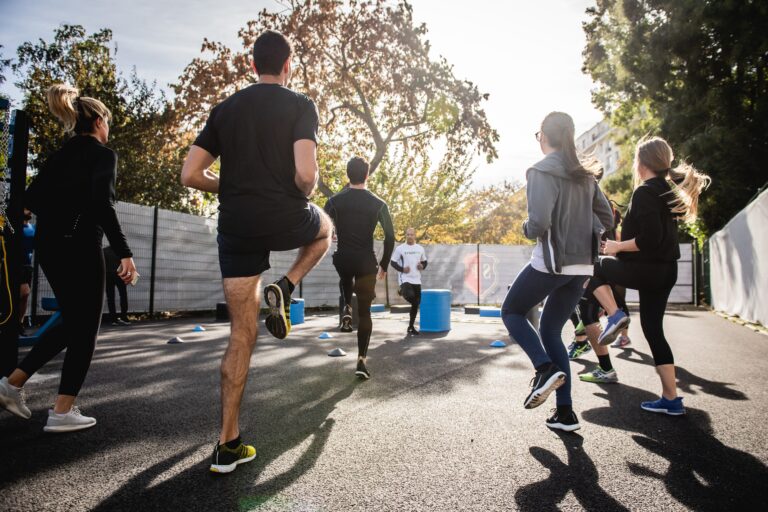How to Start Jogging at 40: A Beginner’s Guide to Fitness and Health

At age 40, taking up jogging can be a terrific method to boost fitness and general health. It’s never too late to start a fitness regimen, despite the fact that it could seem intimidating. Everyone may start jogging at any age, even after turning 40, with the appropriate attitude, preparation, and supervision.
It’s crucial to consult a doctor and obtain a checkup before beginning a jogging routine to be sure there are no underlying medical issues. To avoid damage, it’s also crucial to begin softly and gradually build up duration and intensity over time. Using dynamic workouts like leg swings or walking lunges in your routine will also help your body get ready for jogging.
Starting a jogging habit at the age of 40 can have many advantages, including better cardiovascular health, weight control, and stress reduction. In order to ensure a secure and comfortable experience, it is crucial to pay attention to the body and make modifications as necessary.
Assessing Physical Fitness
It’s crucial to evaluate your degree of physical fitness before beginning a running regimen. You can use this to establish a secure starting point and realistic goals. These are some things to think about:
- Age: Our bodies’ capacity to withstand physical stress declines with age. This needs to be considered before beginning a new workout regimen.
- Weight: Being overweight increases the chance of injury and places additional strain on joints. It’s crucial to begin with low-impact activities and progressively up the intensity as you lose weight.
- Medical issues: A jogging regimen may need to be modified if you have certain medical conditions, such as heart disease, diabetes, or arthritis. Before beginning any new exercise regimen, you should speak with a healthcare provider.
- Current level of fitness: Starting with low-intensity workouts like walking or gentle jogging and progressively increasing the intensity over time is crucial if you are currently sedentary.
- Tests like a stress test or a body composition analysis can be used to evaluate your degree of physical fitness. These assessments can help you establish reasonable goals for your running regimen and reveal important information about your present level of fitness.
But it’s crucial to keep in mind that everyone’s level of fitness varies, so there isn’t a one-size-fits-all method for beginning a jogging regimen. It’s crucial to pay attention to your body’s signals and modify as necessary.
Prevention advises “being gentle with yourself as you advance and being realistic about your starting point.”
Choosing Proper Gear
The appropriate equipment can make all the difference when starting to jog at age 40 in terms of avoiding injuries and guaranteeing a comfortable experience. Here are a few advices:
- Invest in top quality running shoes: According to Nike, selecting a pair of running shoes that provide cushioning, fit your feet, and adapt your jogging style is crucial. Search for footwear with a supportive arch, a snug fit, and a sole that absorbs shock well.
- Wear comfy attire: A full range of motion should be allowed by the apparel you choose. Seek for textiles that drain away sweat so you can jog dry and comfortably. Cotton clothing should be avoided because it tends to hold onto moisture and can chafe.
- Think about investing in a sports watch. These devices may help you monitor your time, distance, and heart rate. This might help you keep track of your progress and modify your program as necessary, according to Marathon Handbook.
It’s crucial to remember that even though the right equipment is essential, you don’t need to spend a lot of money to begin started. Search for deals or discounts on running gear and shoes, and don’t be shy about seeking advice from more seasoned runners.
Creating a Plan
To avoid injury and assure success, starting a jogging routine at 40 involves meticulous planning. The following advice can help you draft a plan:
- Prior to beginning, decide what you want to accomplish, whether it be weight loss, cardiovascular health improvement, or simply enjoying the outdoors. Be honest with yourself about your level of fitness right now and make attainable goals.
- Choose a training program: You can find a variety of training programs online or in books. Pick one that matches your fitness level and goals. The Couch to 5K program, for instance, is a well-liked option for novices.
- Establish a schedule: Choose the days of the week and the number of times you wish to jog. Try your best to stay on schedule.
- Warm up and cool down: Take a few minutes to warm up and cool down before and after each jog. Injuries can be avoided and performance can be enhanced.
- Including days off: As crucial as jogging days are rest days. After exercise, your body needs time to repair and regenerate.
Always pay attention to your body and make necessary adjustments to your plan. If you feel pain or discomfort, go more slowly or stop. Taking it calm and steady is preferable to pushing yourself too hard and endangering your health.
Starting Slowly and Gradually
It might be intimidating to begin a new workout program, especially if you haven’t worked out in a while. To avoid injury and fatigue, it’s crucial to begin gradually. Starting your running routine with a brisk walk or modest jog for at least five minutes is advised by Nike. Your muscles will get a chance to warm up and your body will be ready for the workout.
Once you’ve warmed up, gently pick up the pace until it feels right for you. Don’t exert too much pressure on yourself, especially at first. It’s advisable to take it slow at first and build up your speed and distance over time.
Following a beginner’s running schedule is one approach to gradually improve your pace and distance. A 7-week beginner’s running program, according to Runner’s World, can help you complete your first 5K. Over the course of seven weeks, the strategy steadily progresses from a 30-minute workout to longer runs.
Final Word
Along with adhering to a beginner’s running schedule, it’s critical to pay attention to your body and take rest days as needed. The New York Times advises three days of training per week, with rest or cross-training days in between. Your body will be able to heal and be protected from harm by doing this.
Always start out gently and gradually if you want to develop a routine that will last. Instead of pushing yourself too hard and increasing your risk of injury or burnout, it is preferable to take your time and advance gradually.







Wow, wonderful weblog format! How long have you been running
a blog for? you made running a blog look easy.
The entire look of your web site is wonderful, let alone the content!
You can see similar here sklep online
I love your writing style genuinely loving this web site.
I was looking through some of your content on this internet site and I believe this internet site is rattling
informative! Retain posting.Raise your business
Its like you read my mind! You seem to know so much about this, like you wrote the book in it or something. I think that you can do with a few pics to drive the message home a little bit, but instead of that, this is magnificent blog. A fantastic read. I’ll definitely be back.
Hey there would you mind stating which blog platform you’re working with? I’m planning to start my own blog in the near future but I’m having a tough time making a decision between BlogEngine/Wordpress/B2evolution and Drupal. The reason I ask is because your layout seems different then most blogs and I’m looking for something completely unique. P.S Apologies for getting off-topic but I had to ask!
Definitely, what a fantastic blog and enlightening posts, I will bookmark your blog.All the Best!